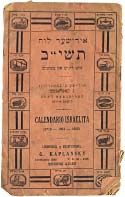The Hebrew or Jewish calendar is a lunisolar calendar used by Jews and the followers of Judaism, now predominantly for religious purposes. It is used to reckon the Jewish New Year and dates for Jewish holidays, and also to determine appropriate public reading of Torah portions, Yahrzeits (dates to commemorate the death of a relative), and daily Psalm reading, among many ceremonial uses. Originally the Hebrew calendar was used by Jews for all daily purposes. In the first century (BCE), the era of the Roman occupation, Jews began additionally following the imperial civil calendar for common matters such as dealings with government officials or tax paying.

The principles of the Hebrew calendar are found in the Torah (the most holy of the sacred writings in Judaism), which contains several calendar-related commandments, including God's commandment during the Exodus from Egypt to fix the month of Aviv as the first month of the year. The Babylonian exile in the 6th century BCE influenced the calendar, including the adoption of Babylonian names for the months.
During the Tannaitic period, the Hebrew calendar was observational. The beginning of each month was determined by the high court and was based on the testimony of witnesses who had observed a new crescent moon. Through the Amoraic period and into the Geonic period, the purely empirical calendar was displaced by calendrical rules. The principles and rules of the current calendar are fully described by Maimonides in the Mishneh Torah.
Because of the roughly eleven-day difference between a twelve lunar month and one solar year, the year lengths of the Hebrew calendar vary in a repeating 19-year Metonic cycle of 235 lunar months. Every two or three years, an intercalary lunar month is added according to defined rules, for a total of 7 times per 19 years. Seasonal references in the Hebrew calendar reflect its development in the region east of the Mediterranean Sea and the times and climate of the Northern Hemisphere. The Hebrew calendar's year is longer by about 6 minutes and 25+25/57 seconds than the present-day mean solar year, so that every 224 years, the Hebrew calendar will fall a full day behind the modern fixed solar year, and about every 231 years it will fall a full day behind the Gregorian calendar year.
Years in the Hebrew calendar are labeled with the era designation Anno Mundi (English: in the year of the world, abbreviated AM or A.M.) and are numbered from the epoch being, by Rabbinical reckoning, a year before the date of Creation. The Hebrew calendar year in early 2009 is 5769.
Day
The Jewish day has no fixed length. A day is modeled on the reference in the Creation story: "...there was evening and there was morning...". Accordingly, a jewish day runs from sunset, the start of "the evening", to the next sunset. However, some apply special rules at very high latitudes when the sun remains above or below the horizon for longer than a civil day.
Because the Jewish scheme has no scheme a civil clock is used. Though the civil clock incorporates local adoptions of various conventions such as time zones, standard times and daylight saving, these have no place in the Jewish scheme. The civil clock is used as a point of reference - in expressions such as: "Shabbat starts at ...". The steady progression of sunset around the world and seasonal changes results in gradual civil time changes from one day to the next based on observable astronomical phenomena (the sunset) and not on man-made laws and conventions. Instead of the international date line convention, the antimeridian of Jerusalem is used. (Jerusalem is 35°13’ east of the prime meridian).
Weeks
Like many other calendars, the Hebrew calendar follows a seven-day weekly cycle. The names for the days of the week are simply the day number within the week. In Hebrew, these names may be abbreviated using the numerical value of the Hebrew letters, for example יום א׳ (Day 1, or Yom Rishon (Hebrew: יום ראשון):
- Yom Rishon (Hebrew: יום ראשון), abbreviated יום א׳ = "first day" = Sunday
- Yom Sheni (יום שני), abbr. יום ב׳ = "second day" = Monday
- Yom Shlishi (יום שלישי), abbr. יום ג׳ = "third day" = Tuesday
- Yom Reviʻi (יום רבעי), abbr. יום ד׳ = "fourth day" = Wednesday
- Yom Chamishi (יום חמישי), abbr. יום ה׳ = "fifth day" = Thursday
- Yom Shishi (יום ששי), abbr. יום ו׳ = "sixth day" = Friday
- Yom Shabbat (יום שבת or more usually שבת - Shabbat), abbr. יום ש׳ = "Sabbath day (Rest day)" = Saturday
Day naming
The names of the days of the week are modeled on the seven days mentioned in the Creation story. For example, Genesis 1:5 "... And there was evening and there was morning, one day". "One day" also translates to "first day" or "day one". Similarly, see Genesis 1:8, 1:13, 1:19, 1:23, 1:31 and 2.2.
The Jewish Shabbat has a special place in the Jewish weekly cycle. There are many special rules which relate to the Shabbat, discussed more fully in the Talmudic tractate "Shabbat".
In Hebrew, the word "Shabbat" (שַׁבָּת) can also mean "(Talmudic) week", so that in ritual liturgy a phrase like "Yom Reviʻi bəShabbat" means "the fourth day in the week".
Months
Biblical references to the pre-Jewish calendar include ten months identified by number rather than by name. In parts of the Torah portion Noach it is implied that the months are thirty days long. There is no indication as to the total number of months in the annual cycle.

In the parts of the Tanakh (the Hebrew Bible) prior to the Babylonian exile, only four months are named: Aviv (first; literally "spring"), Ziv (second; literally "light"), Ethanim (literally "strong" in plural, perhaps referring to strong rains) I Kings 6:38: seventh month; and Bul I Kings 6:38: eighth month. All of these are Canaanite names, and at least two are Phoenician (Northern Canaanite).
According to the Book of Exodus, the first commandment the Jewish people received as a nation was to determine the new moon: Exodus 12:2 states, "This month [Nisan] is for you the first of months." Deut 16:1 refers to a specific month: "Observe the month of Aviv (HE: spring), and keep the passover unto the LORD thy God; for in the month of Aviv the LORD thy God brought thee forth out of Egypt by night."
During the Babylonian exile, which started in 586 BCE, Jews adopted Babylonian names for the months, which are still in use. The Babylonian calendar also used a lunisolar calendar, derived from the Sumerian calendar.
Hebrew names and romanized transliteration may somewhat differ, as they do for כסלו / Kislev or חשוון / Marheshvan: the Hebrew words shown here are those commonly indicated e.g. in newspapers. The Syrian calendar used in the Levant countries shares many of the same names for months as the Hebrew calendar, such as Nisan, Iyyar, Tammuz, Ab, Elul, Tishreen, and Adar.
